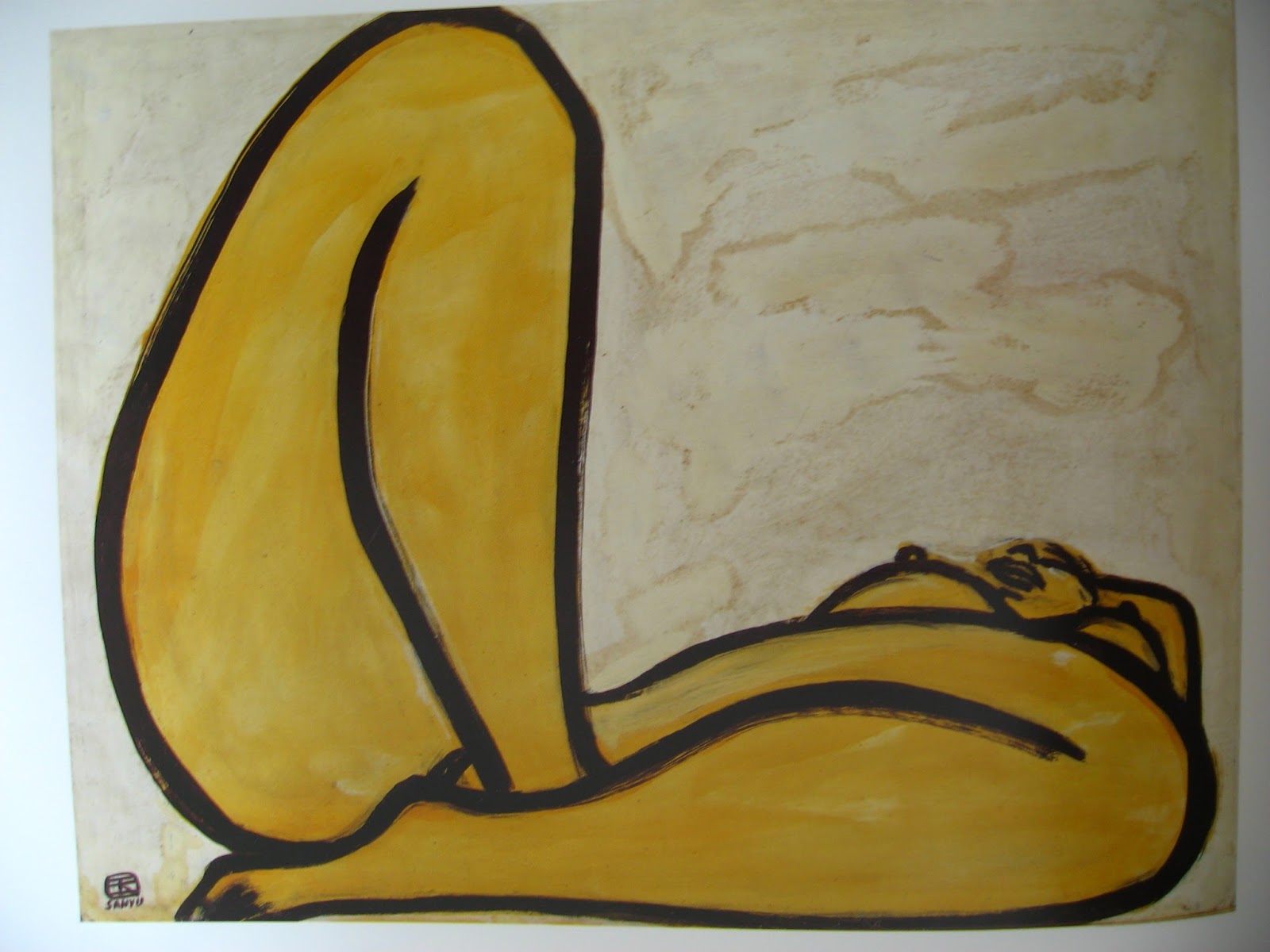==========================================================
Translated by Ann Lee from the Taiwan blog “Elsewhere of Elsewhere”
The picture of Two Swallows in this article is cited from www.shuhua365.com
==========================================================
The Ancient City of Jiaohe, Guan-Zhong WU 1981
102*106cm
(Traditional Chinese Painting)
“How to integrate the aesthetic of the traditional Chinese
painting and western art” is in fact the core question of contemporary Chinese
art. Some artists would hold their ground to the Chinese tradition, some would
search for integration, and some would rather adopt the West entirely. To those
who search for integration, there is a further question that whether the East
or the West should be the content or style of the work. Although I have studied
more than 150 albums of traditional Chinese painting, I am no expert in the
field and can not make good comments yet. I am learning the art and hope that
one day will be able to talk about it.
Fortunately, Wu belongs to those who search for aesthetic
integration. Most masters in this school use western medium or skill, but due
to their profound knowledge and understanding in Chinese culture, their works
naturally reveal the detail of eastern culture unintentionally. These artworks
are usually the master pieces of contemporary Chinese art, hence, it is less
meaningful to distinguish the differences between traditional and integration
school. Formality is unnecessary to enjoy Wu's artwork, because his art has
reached the point beyond the West and
the East, figurative and abstract art. We viewer can appreciate Wu's art by our
own understanding of Chinese culture and judgment of western paintings. My mind
was enlightened when reading Wu's theory of painting. Although his words have
been criticized, I have total faith in his believe and absolutely agree with
him that the beauty of art should be appreciated as a whole. Sole element or
touch of Chinese ink art has no value.
Two Swallows, Guan-Zhong WU 1981
70*140cm (Traditional Chinese Painting)
The computer image of Two Swallows given above is connected by two
images from left to right, thus the picture turns out to be muddy and
artificial. It is better we viewers try to find an album with more precise
colors in print.
We can not avoid talking about the great painter in Qing dynasty,
Shi Tao (around (1641-1718) if we are here to appreciate Wu’s artworks. Wu
devoted in researching Shi Tao’s “A Dialogue on Drawing” and explained Shi
Tao’s thought by saying, “Shi Tao is a painter who focused on his own
sensibility, and firmly claimed that drawing is created according to feelings
and emotions which vary each time.” The understanding of the abovementioned
uncertainty of rules in painting is extremely meaningful in modern art. Many so
called contemporary artists do not figure out this point even three hundred
years later from Shi Tao's era.
Wu applied skills of traditional Chinese painting such as
blank-leaving and stroke in Two Swallows, and deleted unnecessary details to
echo the beauty of abstract and geometry in western aesthetic view. The
composition is extremely simple but strongly expressed Wu's deep observation
and profound love of his motherland. What is real “in love with homeland?” What
is “in love with Taiwan?” (Or in Wu's case, in love with China). Without
shouting out empty slogan loudly, the
great artist showed his sincere affection from his artwork in silence.
Parrot Paradise, Guan-Zhong WU 1988 (Traditional Chinese Painting)
Summertime Number 9A 1948, Jackson Pollock
This is a good example of the difference between creation and
plagiarism, which I repeatedly emphasize, “What element is arisen from the
inner soul of the artist?” “What element is attached from outside?” Artworks of
Wu are definitely originated from his heart.
Although Wu's The Ancient City of Jiaohe, Parrot Paradise, and Spring
Breeze Peach Willow (as follows) all used Pollock’s “drip” technique, Wu's line
and spirit are obviously East, which are completely different from Pollock’s
violent and passionate American style. When a real artist stands at some point
in the art history, he then embodies all the past, including eastern and
western culture (if he has contact with the West), and his creation contains
all his cultures and represents his full character. Wu has found himself
entirely. Whether he learned from any master along his way to perfection, this
is not a question at all. In my eyes, Wu the elderly gracefully embraced
traditional Chinese culture. I see no influences of Pollock anymore.
Spring Breeze Peach Willow, Guan-Zhong WU 1999 45*48cm
(Traditional Chinese Painting)
Due to limitation of words, this article only introduces Wu's four
artworks. Three of them are “Pollock” style, and one is “Two Swallows” style.
We have not gone though all aspects of his aesthetic of art since we have not
yet mentioned Wu's oil and watercolor paintings. Computer imagines here are not
even close to the originals. Hopefully, interested viewers will further
research Wu’s work on their own.
It is said that even at the age of 90, Wu continuously created
more artworks and wished to transform all his life into art. This is indeed
what a real great artist should be. We Chinese have Wu, therefore we have the
hope of never being an inferior people.
2011.9.16 Supplement
Guan-Zhong WU died at
the age of 90 in June 2010. The four Chinese masters of art: Ting-Shih CHEN
(Taiwan), Sanyu and Teh-Chun CHU (overseas), Guan-Zhong WU (China), only CHU is
still alive.









